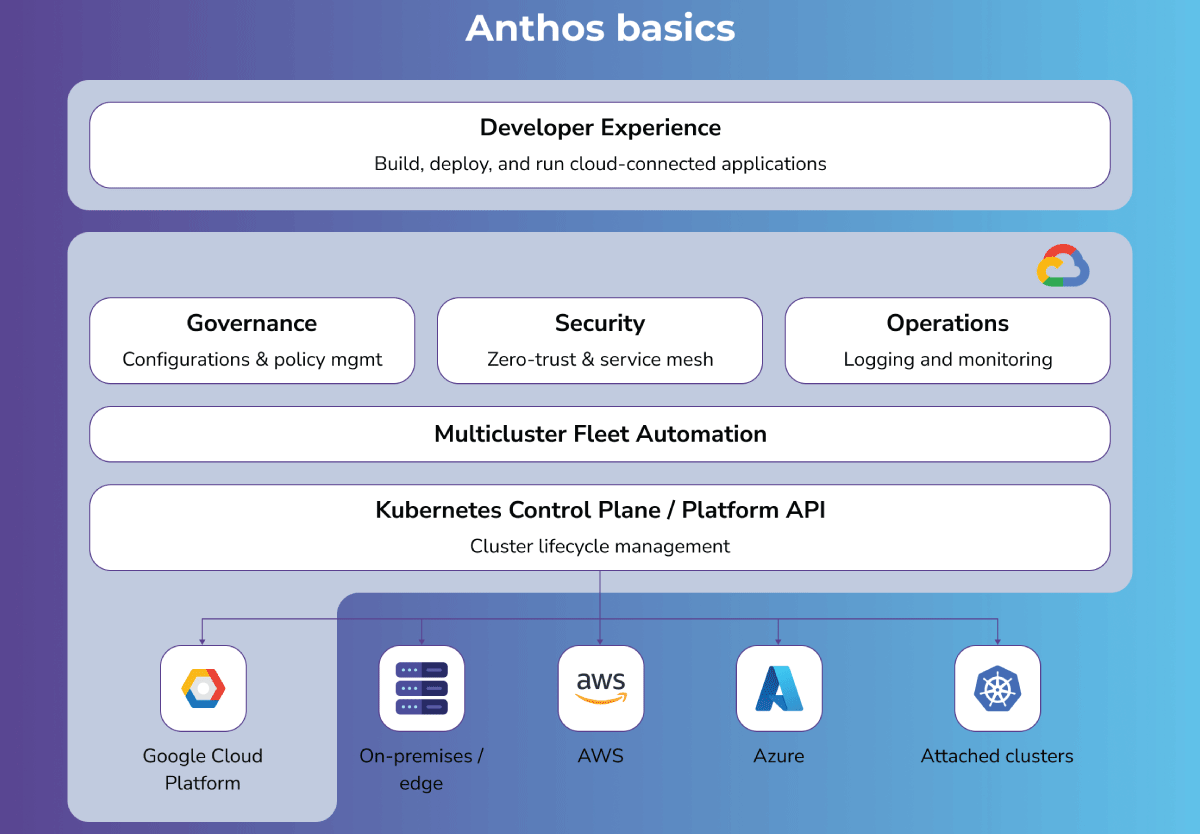- [email protected]
- Mon - Sat: 8.00 am - 7.00 pm
We are creative, ambitious and ready for challenges! Hire Us
We are creative, ambitious and ready for challenges! Hire Us
Over 10 years we help companies reach their financial and branding goals. Engitech is a values-driven technology agency dedicated.
411 University St, Seattle, USA
+1 -800-456-478-23
Anthos is Google's cloud-focused container platform designed to enable the consistent, scalable deployment of modern applications across diverse environments. We will give you the overview of Anthos' functionality and its potential to facilitate the delivery of manageable, scalable, and reliable applications.
Managing clusters across various locations can introduce added complexity and costs. Many organizations leveraging Google Cloud also require the flexibility to run workloads in their own data centers, factory settings, retail outlets, or even in other public clouds. However, they often prefer not to undertake the task of creating container platforms for each of these locations or reevaluating how they configure, secure, monitor, and optimize container workloads, which could result in inconsistent environments, security vulnerabilities, misconfigurations, and increased operational overhead.

Anthos' features revolve around the concept of a 'fleet,' which represents a logical collection of Kubernetes clusters that can be effectively administered as a whole. This fleet may consist of GKE clusters hosted exclusively on Google Cloud or encompass clusters located both within Google Cloud and externally, including on-premises and within other public cloud providers like AWS and Azure.
After establishing a fleet, you can leverage Anthos' fleet-enabled functionalities to enhance efficiency and streamline operations across multiple clusters and infrastructure providers.
Once you've constructed your fleet, Anthos assists in overseeing traffic, authentication, access control, and ensures the consistent implementation of security and compliance policies across your entire fleet.
For the management of connections within hybrid and multi-cloud fleets involving Google services, Google offers a Kubernetes deployment known as the Connect Agent. After installation in a cluster during fleet registration, this agent facilitates the establishment of a connection between your cluster, located outside Google Cloud, and the corresponding Google Cloud fleet host project. This connection enables you to oversee your clusters and workloads through Google and leverage Google services.
To efficiently handle traffic within your fleet, Anthos offers a range of load balancing solutions:
Effectively managing authentication and authorization becomes a significant challenge when dealing with multiple clusters spread across diverse infrastructure providers. Here are some strategies to address this challenge:
Once authentication is established, you can employ standard Kubernetes role-based access control (RBAC) to authorize authenticated users for interactions with your clusters. Additionally, Identity and Access Management can be used to govern access to Google services, including the Connect Gateway.
Managing multiple clusters presents another obstacle in ensuring the uniform application of security and regulatory compliance policies throughout your fleet. Numerous organizations face rigorous security and compliance standards, particularly in sectors like financial services where safeguarding consumer data is paramount. Meeting these requirements at scale is essential.
To address this challenge, Anthos Config Management includes Policy Controller, a tool that enforces customized business logic on each Kubernetes API request directed at the respective clusters. These policies serve as protective "guardrails" and proactively prevent any alterations to the Kubernetes API configuration that may breach security, operational, or compliance guidelines.
Anthos offers a comprehensive set of access control and authentication features to enhance the security of applications operating within your fleet. These include:
A crucial element of effectively managing and operating clusters at scale involves the ability to easily oversee your fleet's clusters and applications, including assessing their health, monitoring resource utilization and ensuring their security posture. Anthos not even ensure ………………????
For more comprehensive insights into your clusters and their workloads, you can leverage Cloud Logging and Cloud Monitoring. Cloud Logging serves as a unified repository for storing and analyzing log data, while Cloud Monitoring automatically gathers and retains performance data, offering data visualization and analysis tools. In the case of most Anthos cluster types, essential logging and monitoring information for system components (such as workloads within the kube-system and gke-connect namespaces) is sent to Cloud Monitoring and Cloud Logging by default. You have the flexibility to further configure Cloud Monitoring and Cloud Logging to obtain insights into your application workloads, establish multi-metric dashboards, create alerts and more.
Within the context of Kubernetes, a service represents an abstract method for exposing an application, operating on a collection of Pods, as a network service. This service provides a single DNS address for routing traffic to the relevant service workloads. In contemporary micro services architectures, a single application may comprise multiple services, each with potentially concurrent deployment versions. Inter-service communication within such architectures relies on network connections, necessitating that services effectively handle network intricacies.